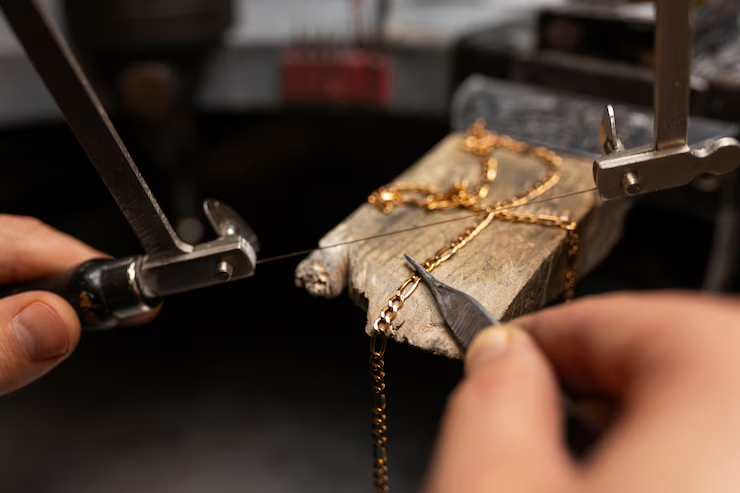The art of jewelry manufacturing has been around for centuries, with each era bringing its unique twist to this timeless craft. However, in today’s rapidly evolving market, manufacturers need to stay ahead by blending traditional craftsmanship with modern advancements. If you’re a jewelry manufacturer, this blog post is your guide to thriving in this dynamic industry.
The Evolving Landscape of Jewelry Manufacturing
Jewelry manufacturing is no longer just about creating beautiful pieces; it’s about innovation, sustainability, and meeting the evolving demands of consumers. The market is more competitive than ever, and staying ahead means constantly adapting and improving. In this post, we’ll explore how Jewelry manufacturer can excel by focusing on quality, sustainability, technological advancements, niche markets, and branding.
Quality Over Quantity
In a world where mass production is the norm, quality craftsmanship stands out. High-quality jewelry pieces are not only visually stunning but also durable and timeless. Focusing on craftsmanship means paying attention to every detail, from the initial design to the final polish. This commitment to quality can set your brand apart and earn the trust of discerning customers.
Craftsmanship involves skilled artisans who understand the nuances of materials and techniques. These artisans play a crucial role in ensuring that each piece is meticulously crafted to perfection. Investing in training and retaining skilled craftsmen can significantly enhance the quality of your products.
High-quality pieces often become heirlooms, passed down through generations, which is a testament to their craftsmanship. By prioritizing quality over quantity, manufacturers can create jewelry that holds sentimental value and stands the test of time.
Sustainable Practices
Sustainability is no longer a buzzword; it’s a necessity. Today’s consumers are more environmentally conscious and prefer brands that align with their values. Jewelry manufacturers can adopt sustainable practices to meet this growing demand and contribute to a greener planet.
One way to incorporate sustainability is by using recycled materials. For example, recycling old gold and silver reduces the need for mining, which is often harmful to the environment. Additionally, sourcing gemstones ethically ensures that your supply chain does not exploit workers or harm ecosystems.
Implementing eco-friendly processes in manufacturing, such as reducing energy consumption and minimizing waste, can further enhance your sustainability efforts. By adopting these practices, you not only appeal to eco-conscious consumers but also contribute to a better future for everyone.
Technology in Jewelry Making
The advent of technology has revolutionized jewelry manufacturing. Techniques like 3D printing and Computer-Aided Design (CAD) have made it easier to create intricate designs and prototypes quickly and accurately. These technologies offer endless possibilities for innovation and customization.
3D printing allows manufacturers to experiment with complex geometries that would be challenging with traditional methods. This technology also reduces material waste and speeds up the prototyping process, enabling faster time-to-market for new designs.
CAD software enables precise design and visualization, allowing manufacturers to create detailed blueprints before actual production. This reduces errors and ensures that the final product matches the initial design perfectly. By integrating these advanced technologies, jewelry manufacturers can stay competitive and deliver exceptional products.
Niche Markets
Identifying and catering to niche markets can be a game-changer for jewelry manufacturers. Niche markets often have specific preferences and are willing to pay a premium for products that cater to their unique tastes and needs.
For instance, creating jewelry that reflects cultural heritage or traditional designs can attract customers looking for pieces that resonate with their identity. Similarly, targeting specific customer segments, such as brides-to-be or fashion-forward millennials, can open new avenues for growth.
By understanding the preferences of these niche markets and tailoring your designs accordingly, you can create a loyal customer base that appreciates the uniqueness and exclusivity of your products.
Building a Brand
In an industry as competitive as jewelry manufacturing, building a strong brand is essential. A well-defined brand identity and effective marketing strategies can help you stand out and connect with your target audience.
Your brand should reflect your values, craftsmanship, and unique selling points. Consistent branding across all touchpoints, from your website to packaging, creates a cohesive and memorable experience for customers.
Effective marketing strategies, such as leveraging social media, influencer collaborations, and content marketing, can boost your brand’s visibility and engagement. By telling your brand’s story and showcasing your expertise, you can build a loyal customer base that trusts and values your products.
Conclusion
The jewelry manufacturing industry is evolving, and staying ahead requires a blend of traditional craftsmanship and modern innovations. By prioritizing quality, adopting sustainable practices, leveraging technology, exploring niche markets, and building a strong brand, manufacturers can thrive in this dynamic landscape.




